Bushfires: ‘Life was good and then one morning we woke up and it was taken from us’
Beekeeper, Karl Zeigler, 92, stood frozen to the spot, his blue eyes wide with horror as angry flames devoured his home of 50 years.
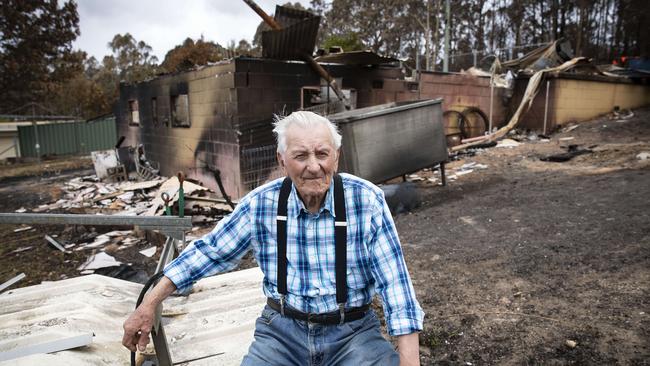
The twisted, smoking wreckage that was once the tiny town of Mogo on the NSW south coast tells the tale of a paradise lost.
There are the blackened ruins of more than a dozen homes. The ashen remnants of the tearooms. The charred skeleton of the bookshop. The flattened store of the leather retailer.
A floral design in pressed metal — on a slab of stone that was once an altar — is all that is left of the town’s much-loved pottery store, which had been beautifully housed in a deconsecrated church.
Many of the shell-shocked locals of the town — population 322 — returned to Mogo only this week to witness the destruction in the wake of the bushfire that roared through the region on New Year’s Eve.
Peter and Vanessa Williams, who settled in Mogo about 40 years ago, raised their two children in the town and built Mogo Pottery — one of the town’s tourist drawcards — into a thriving business and a community hub.
Speaking to The Weekend Australian this week, Peter said the sight of their scorched properties was too much for the couple to bear. “Life was good and then one morning we woke up and it was taken from us,” he said. “We’ve been waking up in a panic. You know, I’m 69, and it’s like starting over again as teenagers.”
After receiving an emergency text message with the warning ‘‘Get out’’ on December 31, Peter had bundled up the most precious items from their home and shifted them to the pottery store, wrongly believing they would be safer there.
“Vanessa wanted to stay back and save the house,” he said.
“She had it like a gem. We were so proud of the house and used to show people through and say ‘Look at this’. It was magnificent.”
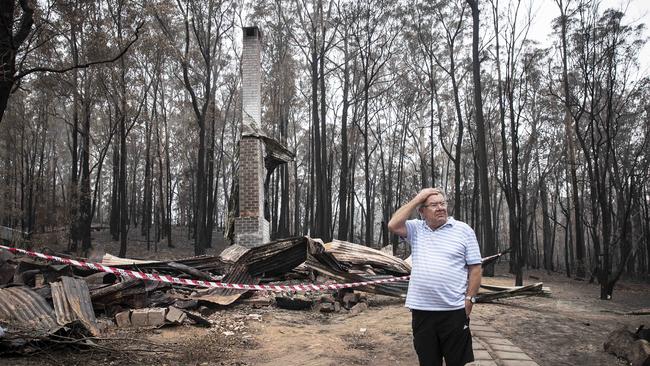
The Williams’s close friends Phil Mayberry and Gayle Smith are among the lucky ones. The couple, whose 1870s-era timber house and garden nursery on Mogo’s main street are still standing, fear life will never be the same now that the “Willys”, whom they first followed to Mogo, have gone.
“In the early years, we would sit up at the pottery there with a beer,” Phil said, tears in his eyes.
“It’s just been a sensational community-driven town.”
Along with the pottery, the bookstore, the leather shop and tearooms, the Local Aboriginal Land Council building was also destroyed by the fires.
“The indigenous people in Mogo are such hardworking and community-minded people,” Phil said.
Over at the Boomerang Meeting Place, longtime Mogo residents Maryanne and Andrew Nye have spent the past week co-ordinating the arrival of semi-trailer loads of donations, which have steadily rolled in since the fire, with a local army of volunteers on hand to unload water bottles and crates of food.
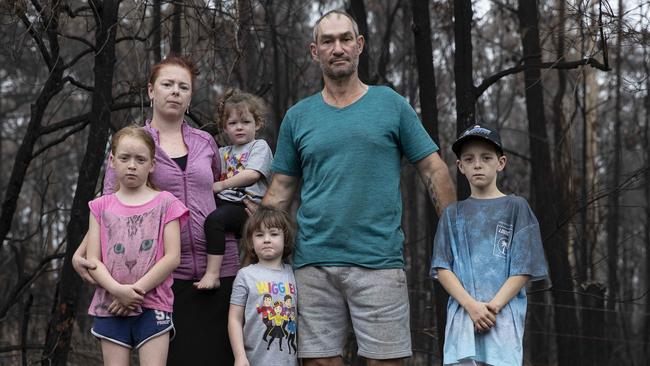
“They’re coming back with another truck on Sunday,” Maryanne said. “It makes you feel good to know there are people out there who really care.
Andrew, who has lived in Mogo most of his life, said the fire was one of the scariest things he had seen in his 70 years.
“We stayed as long as we could and left at the last moment.”
After the firestorm had passed, he returned with his son, driving in silence as they turned in to their street, readying themselves for the worst.
“My heart was racing because I didn’t know if I was coming back to a home,” he said. “Our good friend’s house was gone and then at the top of the hill, Karl, who we have known all our lives, his house was gone. We felt so relieved to see our houses but we couldn’t really be happy because we’ve seen all the destruction and those people have lost a history of theirs that cannot be replaced.”
While Karl Ziegler lost his home of 50 years in the blaze, the bravery of his friends in Mogo may have saved his life.
The 92-year-old beekeeper, known by locals as the “honey man”, stayed in Mogo as the fire approached but could only watch on helplessly as flames devoured his home.
While strong for his age and still able to carry trays laden with honeycomb, he couldn’t outrun the fire. Luckily, he didn’t have to.
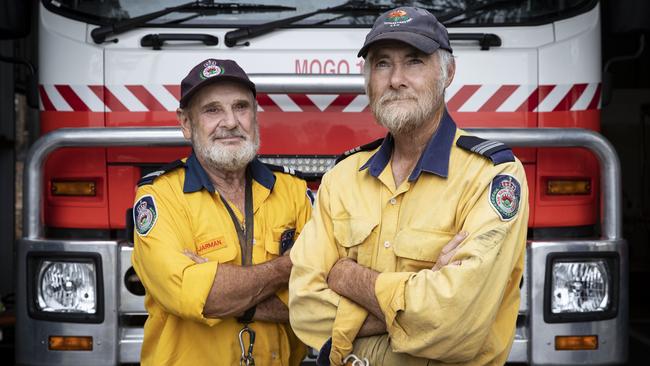
He was plucked from the horror by a neighbour, Keith “Punt” Nye, who burst from the black smoke in his ute.
When asked about his lucky escape, Karl shuddered involuntarily. “It was worse than the war …” he said, his voice trailing off.
Mogo fire chief Frank Ziegler — one of Karl’s sons — had just finished a 13-hour shift fighting a blaze at the nearby Deua firefront when a crackle came over the radio.
“We heard Mogo was in trouble and came straight here,” Frank told The Weekend Australian outside the town’s Rural Fire Service shed on Thursday.
“The fire was larger than what we were. It’s as simple as that.”
So intense was the windstorm created by the flames that Frank and his team of fellow firefighters were repeatedly knocked to the ground by its force.
“The water we were squirting at it is very high pressure, but it was going no more than probably 2½ metres and coming back at us as steam,” Frank recalled.
“That’s how hot it was.”
The odds were stacked against them from the beginning. The small RFS crew, numbering fewer than 12, was soon overrun and the blaze thundered into town.
“Every time you turned around, you could just see more and more spot fires.
“We knew we couldn’t catch it,” Frank said.
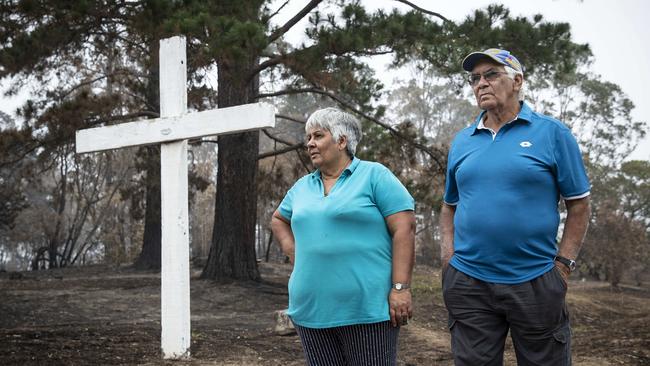
“We just kept falling back and falling back. We tried to save as many houses as we could. But once that house was gone, we would just fall back and try and save the next.”
His father Karl is unsure whether he’ll be able to rebuild in Mogo. His home and its life-time of memories, and a shed full of his beekeeping equipment, were incinerated. All that remains is a couple of drums of honey.
Karl, who migrated to Australia from Germany in 1955, says he was first attracted to Mogo for its isolation. “There were about four families and no one was around to tell me what to do,” he said.
In the wake of the devastation, the town again bears an eerie resemblance to the Mogo of several decades ago. It will take several years for the local population, and its economy and its flora, to regrow and replenish.
But Karl, like so many in Mogo, hides his hurt behind a philosophical outlook “It’s schicksal,” he said, using the German word for fate.




To join the conversation, please log in. Don't have an account? Register
Join the conversation, you are commenting as Logout